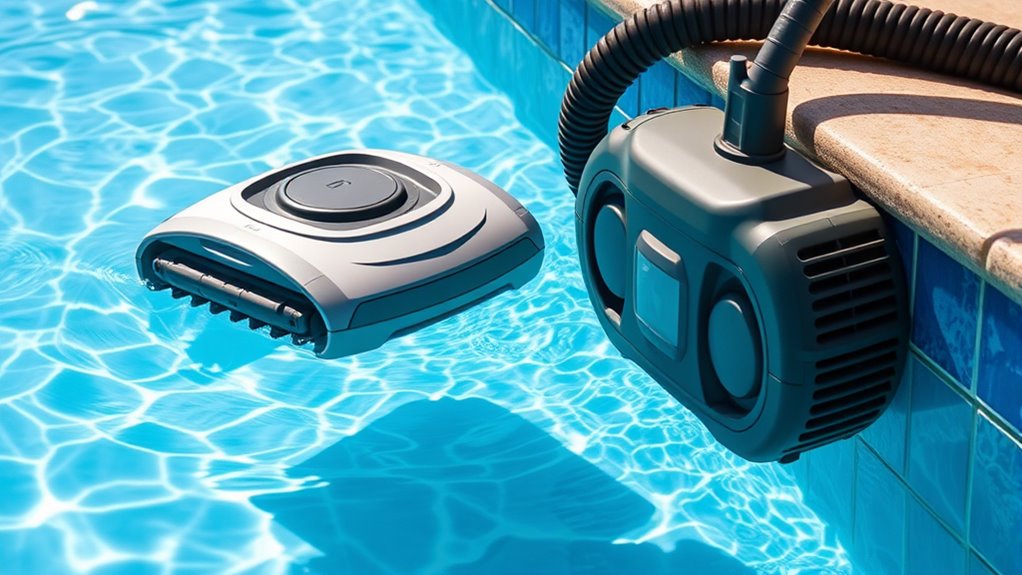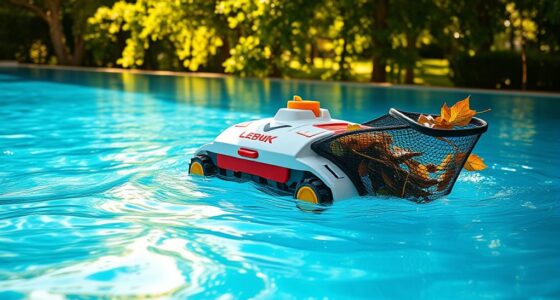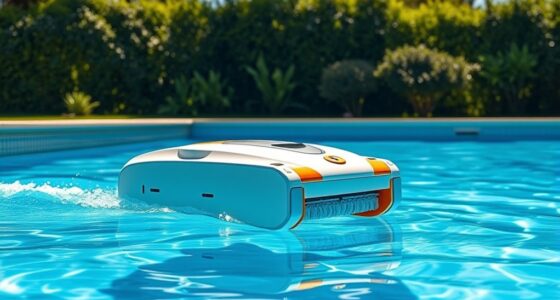Robotic pool cleaners are easy to use and offer thorough cleaning with smart navigation, making them ideal for complex shapes and ongoing convenience. Suction cleaners are simpler and less expensive upfront but may require more manual effort and less effective coverage. Robotic models tend to cost more but save energy and time long-term, while suction cleaners are budget-friendly options for straightforward pools. To discover which suits your pool best and why, explore the details further.
Key Takeaways
- Robotic cleaners offer advanced navigation, thorough coverage, and better debris filtration, making them ideal for complex pool shapes.
- Suction cleaners are typically more affordable upfront and easier to operate, suitable for simple, rectangular pools.
- Robotic models tend to have higher initial costs but provide long-term savings through energy efficiency and reduced manual maintenance.
- Suction cleaners are less sophisticated technologically but are durable and effective for basic cleaning tasks.
- Robotic cleaners excel in cleaning efficiency, obstacle detection, and adaptability, while suction cleaners are straightforward but less precise.
Ease of Use and Convenience
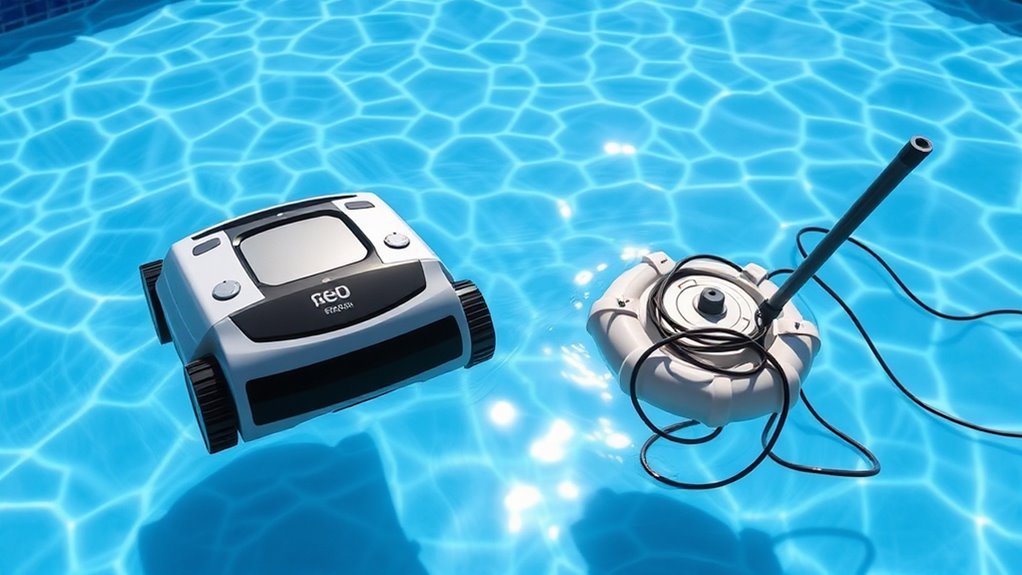
When it comes to ease of use and convenience, robotic pool cleaners generally offer a more user-friendly experience than suction models. With robotic cleaners, you don’t need to worry about manual operation or adjusting settings constantly. They come with intuitive controls, allowing you to set a cleaning schedule or start a session with just a few taps or a press of a button. Unlike suction cleaners, which often require manual intervention or repositioning, robotic models are designed for straightforward operation. Many feature remote controls or smartphone apps, giving you greater user control without the hassle. This simplifies maintenance and minimizes the effort needed to keep your pool clean, making robotic cleaners a more convenient choice for most pool owners. Additionally, some models are compatible with support hours, enabling you to troubleshoot or get assistance when needed. Properly maintaining the cleaning system can further enhance their ease of use and reliability.
Cleaning Performance and Effectiveness
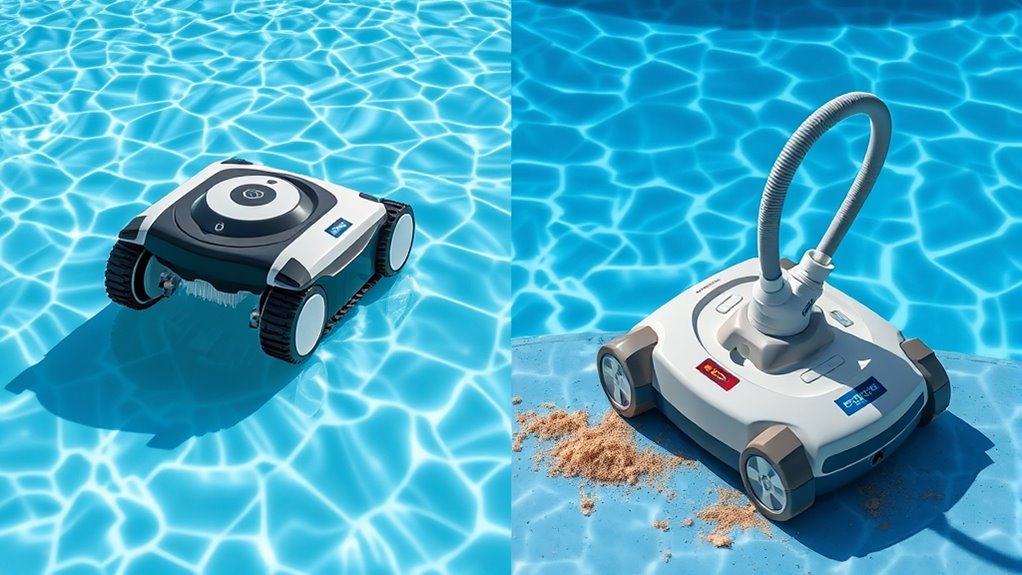
Robotic pool cleaners often deliver superior cleaning performance compared to suction models because they are designed to thoroughly navigate and scrub your pool’s surfaces. Their filtering capacity allows them to trap fine dirt, algae, and debris more effectively, ensuring cleaner water. These cleaners move systematically across the pool floor, walls, and waterline, providing all-encompassing coverage. Debris removal is efficient, as robotic cleaners often have larger, more advanced filters that can handle larger volumes of debris in one cycle. This means you spend less time manually skimming or vacuuming. Overall, robotic cleaners excel at maintaining a high level of cleanliness, making them a reliable choice for thorough, consistent pool upkeep.
Cost and Budget Considerations
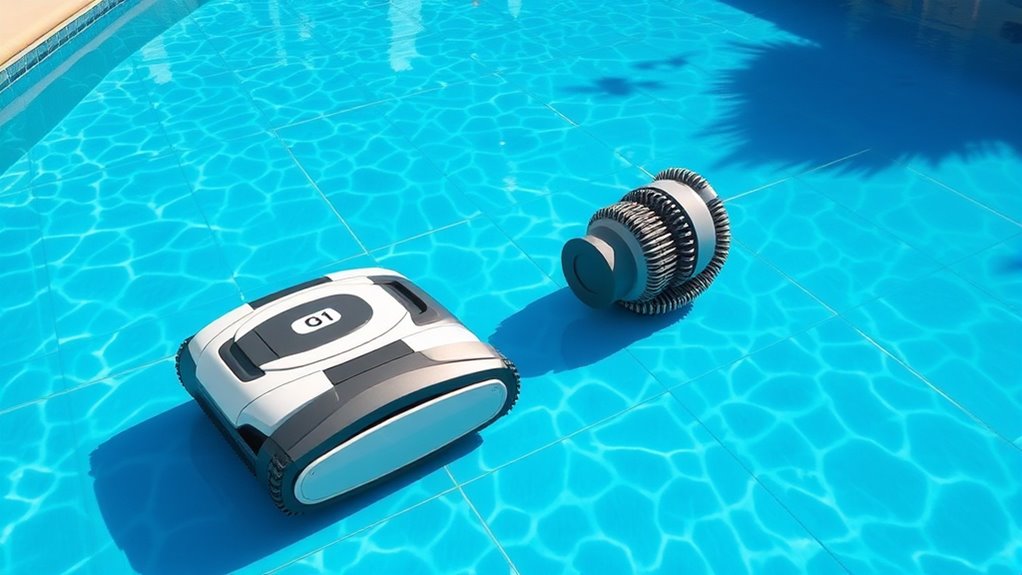
When choosing between robotic and suction pool cleaners, you’ll want to take into account the initial purchase price and how it fits your budget. Operating expenses, like maintenance and energy costs, can add up over time, impacting your overall savings. Evaluating long-term costs helps you determine which option offers the best value for your money. Additionally, considering the types of upgrades available can influence maintenance requirements and durability, ultimately affecting your overall investment. For example, advanced features such as programmable cleaning cycles or enhanced filtration can add to the upfront cost but may improve efficiency and longevity. Furthermore, understanding how the technology used in projectors impacts durability and performance can help you make a more informed choice for your pool cleaning needs. Being aware of consumer reviews and feedback can also provide insights into the real-world performance and reliability of different models, aiding your decision-making process. Moreover, considering the personality traits of manufacturers can give you an idea of their customer support quality and product innovation.
Initial Purchase Price
The initial purchase price of pool cleaning devices varies considerably between robotic and suction models, making it a key factor in your budget considerations. Robotic cleaners tend to be more expensive upfront, often reflecting strong brand reputation and advanced features. Meanwhile, suction models generally cost less initially but may lack some of the high-tech benefits found in robotic options. When comparing prices, consider the available color options, as some brands offer customizable or limited choices, which could influence your decision. Keep in mind that higher-priced models might offer better durability or brand reliability, potentially saving you money long-term. Additionally, understanding the cost of maintenance and energy consumption can help you make a more informed decision. Properly assessing device capabilities and the long-term value can significantly impact your overall satisfaction. Also, evaluating the technology features that come with each type can help you determine which model aligns better with your cleaning needs and expectations. For example, robotic models often include advanced navigation systems that improve cleaning efficiency and coverage. Ultimately, your choice depends on balancing your immediate budget with the value you expect from the device’s features and reputation.
Operating Expenses
While the initial purchase price is important, considering the ongoing operating expenses is essential for understanding the true cost of pool cleaners.
- Energy consumption impacts your monthly electricity bill, especially for robotic models that run frequently, and choosing energy-efficient solar-powered options can help reduce costs.
- Repair costs can add up over time, particularly if parts wear out or break unexpectedly.
- Maintenance expenses, such as replacing filters or batteries, also influence your budget.
- Proper operation and regular cleaning can extend the lifespan of your equipment, reducing overall costs and downtime.
- Additionally, understanding filter replacement schedules can help users choose the most effective cleaning tools for their needs, ensuring long-term satisfaction and investment protection.
- As technology advances, newer models may incorporate more energy-efficient components, which could lower ongoing costs over time.
Long-Term Savings
Choosing the right pool cleaner can lead to significant long-term savings by minimizing ongoing costs. Robotic cleaners tend to be more energy-efficient, which reduces electricity bills over time. Their precise cleaning routines also lessen wear and tear on your pool’s equipment, lowering maintenance expenses. Advanced cleaning technology in robotic pool cleaners improves their effectiveness and durability, leading to further savings. Additionally, robotic models often incorporate energy-efficient motors, which enhance their performance while consuming less power. These motors contribute to a lower environmental impact, making robotic cleaners a more eco-friendly option. Suction cleaners, while generally cheaper upfront, may consume more energy and require frequent repairs, increasing costs in the long run. Furthermore, robotic cleaners can adapt to different pool sizes and shapes, ensuring thorough cleaning with less manual intervention. Additionally, robotic models often have a lower environmental impact due to their energy efficiency and reduced water waste. Investing in a robotic cleaner might seem costly initially, but the savings on energy, maintenance, and environmental impact make it a smart choice for long-term budget considerations. Ultimately, choosing a cleaner with high energy efficiency benefits both your wallet and the environment. Incorporating newer technologies in robotic pool cleaners can further enhance their efficiency and durability, leading to even greater long-term savings.
Maintenance and Durability

Robotic and suction pool cleaners both require regular maintenance to keep them functioning efficiently, but their durability can vary considerably. You’ll want to pay attention to corrosion resistance and component quality, as these factors determine how long your cleaner lasts. Proper upkeep extends the lifespan and ensures consistent performance.
Regular maintenance boosts the lifespan and performance of robotic and suction pool cleaners.
- Regularly inspect and clean filters and brushes to prevent buildup and damage.
- Check for signs of corrosion or wear, especially on metal parts, and replace damaged components promptly.
- Store your cleaner in a dry, shaded area when not in use to avoid unnecessary exposure to harsh elements.
Features and Technology
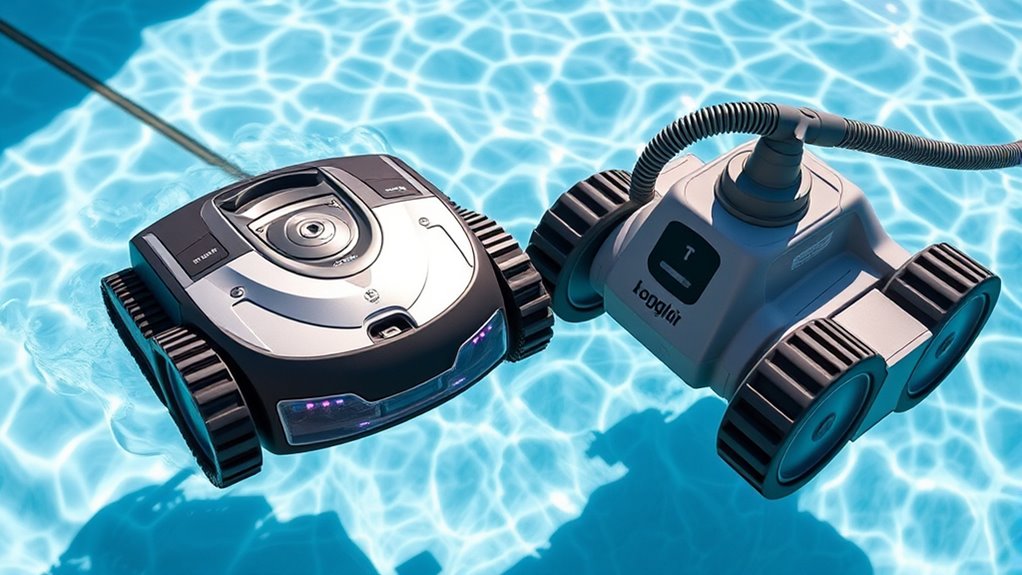
When comparing features, you’ll notice that robotic cleaners often use advanced navigation and mapping to cover your pool efficiently, while suction models rely on basic movement. Cleaning power and efficiency vary considerably between the two, affecting how well they remove debris and dirt. Understanding these technological differences helps you choose the right cleaner for your pool’s specific needs.
Navigation and Mapping
Navigation and mapping are essential features that determine how effectively a robotic or suction pool cleaner can cover your pool’s surface. Good navigation depends on sensor accuracy and obstacle detection, ensuring the cleaner moves efficiently without missing spots or getting stuck.
- Robotic cleaners often use advanced sensors and mapping technology, allowing them to create detailed floor plans and navigate complex pool shapes.
- Suction cleaners typically rely on random movement, with limited obstacle detection, which can sometimes result in missed areas.
- The better the sensor accuracy, the more precise the navigation, reducing the need for manual intervention and increasing cleaning coverage.
Ultimately, advanced navigation and mapping tech improve cleaning efficiency, making robotic cleaners a smarter choice for thorough pool maintenance.
Cleaning Power and Efficiency
Advanced sensors and mapping technology not only help robotic cleaners navigate efficiently but also enhance their cleaning power. These features allow robots to target dirt and debris precisely, maximizing coverage and effectiveness. However, automation complexity can influence cleaning performance, as more advanced systems may require longer setup and calibration. Robotic cleaners often use less power overall, thanks to intelligent movement patterns that conserve energy, making them more efficient in the long run. Suction pool cleaners, on the other hand, rely on continuous power and straightforward mechanisms, which can deliver robust cleaning but may consume more energy. Ultimately, robotic cleaners combine innovative tech with optimized power use to provide thorough, efficient cleaning, whereas suction models prioritize raw power and simplicity.
Suitability for Different Pool Types
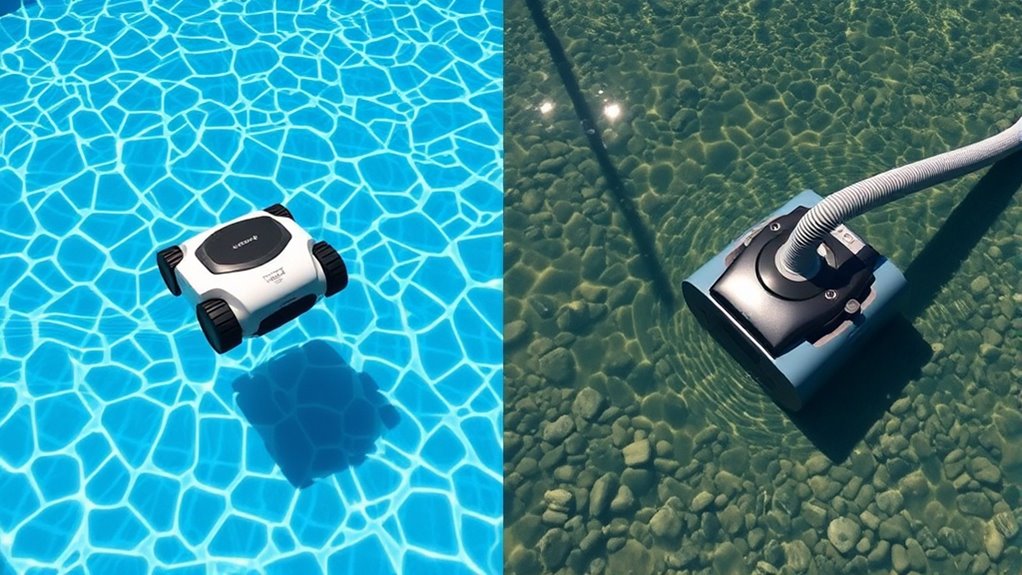
Robotic and suction pool cleaners each excel with different types of pools, making it important to choose the right one for your specific setup. Your pool’s shape and water chemistry influence their effectiveness.
- For irregular or complex pool shapes, robotic cleaners are ideal because they navigate more thoroughly.
- Suction cleaners work well in simple, rectangular pools with stable water chemistry, simplifying maintenance.
- If your water chemistry fluctuates or has high calcium levels, robotic cleaners are better since they tend to handle mineral buildup more efficiently.
Robotic cleaners adapt easily to various shapes and water conditions, while suction models are best for straightforward pools. Understanding your pool’s shape and water chemistry helps you make the right choice.
Frequently Asked Questions
Which Type of Cleaner Is Better for Irregularly Shaped Pools?
When choosing a cleaner for irregularly shaped pools, consider pool shape considerations, as some cleaners handle complex edges better. Robotic cleaners often excel in maneuvering intricate patterns and corners, offering superior cleaning pattern efficiency. Suction cleaners may struggle with irregular shapes, leaving spots untouched. So, for irregular pools, a robotic cleaner is usually the better choice, ensuring thorough coverage and effective cleaning across all areas.
How Do Robotic and Suction Cleaners Handle Stubborn Debris?
When dealing with stubborn debris, you might find robotic cleaners more effective because they can navigate complex shapes and reach tricky spots, reducing the need for manual scrubbing. Suction cleaners often struggle with debris stuck in corners or on rough surfaces. For persistent debris, combining chemical treatment to loosen it and manual scrubbing guarantees a thorough clean, especially in irregularly shaped pools. Robotic cleaners make this process easier and more efficient.
Are There Eco-Friendly Options Among Robotic and Suction Pool Cleaners?
You’ll find eco-friendly options among robotic and suction pool cleaners that emphasize energy-efficient designs. These models consume less power, helping you reduce your carbon footprint while keeping your pool clean. Look for units with energy-saving features or made from sustainable materials. By choosing these eco-friendly options, you enjoy efficient cleaning without sacrificing environmental responsibility, making your pool maintenance more sustainable and cost-effective in the long run.
Can Robotic and Suction Cleaners Be Used Simultaneously?
You can use robotic and suction pool cleaners together for dual operation, which boosts cleaning efficiency. Running both simultaneously helps cover more area and reaches stubborn dirt, ensuring a thorough clean. Just make sure your pool’s filtration system can handle both devices at once. Using them together saves time and improves overall cleanliness, especially in large or heavily soiled pools. Always check manufacturer guidelines to prevent any potential issues.
What Safety Features Should I Look for in These Cleaners?
When choosing pool cleaners, look for safety features like robust safety mechanisms and hazard detection systems. These features automatically stop or adjust the cleaner if they detect obstacles, entanglements, or potential hazards. This helps prevent accidents and damage to your equipment. Ensuring your cleaner has reliable safety mechanisms and hazard detection will give you peace of mind while keeping your pool clean and safe for everyone.
Conclusion
Choosing between robotic and suction pool cleaners is like selecting the right tool for a busy gardener—each has its strengths. Robotic cleaners are like high-tech robots, offering advanced features and thorough cleaning, while suction models are dependable workhorses that get the job done with simplicity. Consider your pool size, budget, and cleaning needs. Whichever you pick, investing in the right cleaner will keep your pool sparkling like a jewel in the sun.
